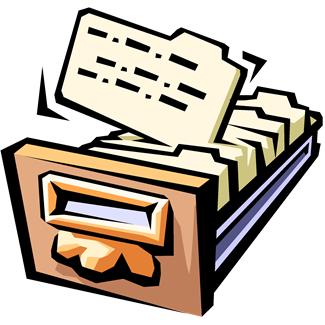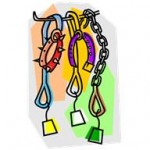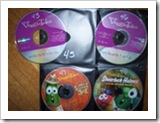Stephanie Calahan, of Calahan Solutions and a Paper Tiger Expert shares 3 great tips in this article to eliminate the avalanche of paper piles. Be sure to watch the video she mentions later in this article to help you create an action system that works for you!
Stephanie recognizes, as we do, that different people need different tools to help with their daily lives, including Paper Tiger Filing System and Document Management Software, which she recommends based on her clients’ needs and the way that they work. She understands that every person is different and requires systems that work for them.

Your desktop, and frankly any other horizontal surface, are the hardest places to keep clear of paper. Bills to pay, to-do lists, event invites, magazines you have been meaning to read, orders you need to fill, and the list goes on and on.
Often, we keep things “out” – either spread around or stacked – on our desk and other surfaces because we don’t want to forget to do something that we have deemed important or don’t want to forget.
Today I’ll share 3 tricks that have worked for me and my clients.
Rather than thinking of your papers in terms of a topic or a list of things that you need to do, think in terms of “next action.” You may have many things that ultimately need to happen with a particular piece of paper, but by only thinking of the next action, you can eliminate overwhelm and process your paper faster. (If there is no action necessary, skip to trick #3)
Once you have determined the next action, either write it directly on the paper, or attach a sticky note to the page with the next action you need to take. If you know the information, also write down how and when you will best perform that action. By writing down the action you need to take, you will save yourself loads of time later when you pick up the paper again! Why rethink about an action over and over when you can decide once and move on?
Example: I was working with a client the other day and we were going through his paper work. He picked up a piece of paper that contained a name and phone number of a contact. He told me that his next action was to make a phone call to that person for a project they were working on together. I then asked him if he had everything he needed to make the call successful. No. He didn’t. He had to do some quick research first. So, the next action was not the phone call, it was the research.
When you have action items, it is OK to mix various project or topics as long as they are organized by the type of action you need to take.
Create an Action System! Action Systems come in a number of different forms. One way is to label file folders with each Verb and store your papers in those file folders on your desk in a vertical file holder (the graduated kind where you can see all of the file tabs is best) or you could use the Pendaflex PileSmart Organizer. This way, the items are stored in an orderly fashion until you make time to take action. You might have something like this:
– Call
– Write
– Review/Decide
– Pay
For a detailed look at how that might work for you, check out the video I did on YouTube a while back – Creating an Action Filing System for the Way You Work.
The Action System is great to keep things looking neat, but you must actually open the folders and take action to get the full benefit! By taking action by verb or type of action, you will eliminate multi-tasking, save time and increase concentration. If possible, it is best to empty each folder in one sitting. Once you have completed the action, ask “What is the next action?” and file accordingly.
Example: The paper my client had identified with the contact and phone number originally went into a “Research” folder. Once he had completed the research, he added that information to the paper and moved the page from “Research” to the “Call” folder. When the call was complete, he would either toss the paper, or file it into permanent reference or assign it a new action based on the results of the call.
Sometimes we keep papers on our desk because there is information that we want easily accessible but there really isn’t an action needed. Start by making sure that the information really is needed for quick reference. If you don’t need the information on at least a weekly basis, file it away in your permanent reference files.
The fastest way to create a quick reference system is to get a 1 – 1 1/2 inch binder and a numbered tab system. Either 3-hole punch each page or put them in sheet protectors. Each topic gets its own number. At the front of the binder, have an index to tell you what each number represents. You might have something like this:
1 — Emergency Contacts
2 — Service Providers
3 — Passwords
4 — Product Codes
and so on.
Once you have your Action System and Quick Reference system in place, it is a matter of consistently asking yourself “what is the next action” and then processing the paper. These small decisions will help you keep the paper piles under control and eliminate avalanche concerns. Before you know it, you will be getting things done rather than pushing papers around your desk!
If you would like help getting all of your paper piles figured out and systems put in place that match the way you think and work, let’s talk!
To your success!
About the Author:
Stephanie Calahan is The Business Vision Catalyst and founder of Calahan Solutions, Inc. She works with purpose-driven entrepreneurs, visionaries, coaches, consultants, health practitioners, authors, speakers and all sorts of remarkable service professionals who are experts in their field, to help them embrace their brilliance, leverage their business and get their message out with power, ease and joy; so that they can make a powerfully positive difference in the world, exponentially grow their income and enjoy a highly-successful and meaningful business… while working less. Learn how you can have more freedom in your life! http://www.StephanieCalahan.com

Meggin McIntosh, is “The Ph.D. of Productivity”™ and a Paper Tiger Expert. She will help you better understand Paper Tiger Filing System Software for document management to be able to use the software more effectively and see how you can get organized in every area of your life — not just paper filing! Meggin has been able to file & find paper files, notebooks, boxes, and lots more for over 13 years.
Click here to see a pre-recorded class Meggin taught where she shows how she has used Paper Tiger for over 13 years.
About Meggin McIntosh
Meggin McIntosh, Ph.D., “The Ph.D. of Productivity”(tm). Through her company, Emphasis on Excellence, Inc., Meggin McIntosh supports smart people who want to be more productive so that they can consistently keep their emphasis on excellence.
Phone: 775.853.5510
And to keep moving forward on your goals for more peaceful productivity, join others (worldwide) who receive Meggin’s weekly emails, and see what is available for download at no cost at any of MEGGIN’S WEBSITES:
http://meggin.com (Primary site)
http://GetaPlanGuides.com
http://KeepingChaosatBay.com
http://TopTenProductivityTips.com
http://JustWhelmed.com
http://OwningWordsforLiteracy.com
http://PumpernickelPublishing.com
http://StayingPositiveinaFreakedOutWorld.com
http://LifeofEs.com
Twitter • www.twitter.com/MegginMcIntosh

Just because you run your office out of your home, you don’t have to treat your home office any differently than if it were a rental or a location where you work for someone else. You can enjoy all the comforts and luxuries of working from your home while still maintaining the professional atmosphere that can help you stay motivated and be successful. This is especially important if you use your home office to meet with potential clients or other business professionals in the industry. Having an office that is disorganized will only cause others to doubt your level of professionalism.
Furniture that is comfortable yet exudes professionalism is a good way to start, but is only a small part of what matters. You could have the most expensive home office furniture available on the market, and none of it will matter if it is all buried under clutter. Too often those who work from the home, alone or with only one or two other staff members, tend to slack a bit when it comes to keeping things neat and tidy. It is crucial to get a good filing system and organization method in place and work hard to maintain it. Getting organized will save time in the long run and make it easier for you or anyone who uses the home office and will also improve the way in which your office space is perceived.
The best way to get things in order from the start is to implement Paper Tiger Filing System Software for document management, an indexing system that can help you organize your paper files and so much more. Even if you already have a filing system in place, incorporating Paper Tiger’s indexing system into your home office will only help improve upon what you’ve started and will also make it much easier for other people to use the system to locate documents and other physical items, such as books, training manuals, software, keys, office supplies, etc.
By entering item names and keywords into the indexing system relating to your documents, you can find anything by conducting a Google-like search of the information in your database. After you have your system set up, you will help eliminate certain problems such as dealing with different staff members not being able to locate files because they aren’t sure where to look. For example if you have a file for “Steven Mackey’s Home Repairs” you can also use search terms that are related like “Mackey,” “Repair,” or anything else you can think of that you might have filed it under. No matter what you or someone else types in from these search terms, the document or file can be located based on the keywords that were entered when filed. You can add keywords anytime, especially when you need to file a new document into an existing hanging file folder.
With Paper Tiger, you would number your hanging file folders to relate to the database index, enter the data into the software relating to each document or set of relating documents such as the item name and additional keywords that you might relate back to the files in each hanging file folder, and never have problems retrieving your data again, and you can also rest assured that you or someone else will be able to find the file at a later date.
For example, you can enter key search terms such as “taxes,” “expenses,” receipts,” or “write offs” all entered for the same file. Later you can use any of these terms and the search engine will inform you of where the file is located. No more searching because you can’t remember if you filed it under ‘T’ for taxes or ‘E’ for Expenses or ‘R’ for receipts, etc.
Even if you already have your filing system in place, you can easily make the change to an indexing system that works that much better. For additional instruction, see the following articles that you might find helpful:
Make your home office run smoothly and more effectively, as well as more professional, by getting organized and implementing Paper Tiger Filing System software.

Are you still using an alphabetical method paper filing system? Or maybe you’re using the ‘stack’ method? If you are, you may be wasting a whole lot of time when you could use a file indexing system to find any file you need in seconds and be more productive. You can make your employees’ jobs, and your own, a whole lot easier by implementing Paper Tiger Filing System Software. This is going to make it a whole lot easier for you and your employees to find files quickly when they need them, and they won’t be wasting any time sifting through stacks of paper files.
Just think of how much time can be saved, how this time can be used more productively and, in the long run, you are going to be saving money.
You may wonder how this is going to save you money. Think about it for a minute. When you or your employees are busy searching for files, they are not really getting anything done. This means that some work will either get behind or employees will have to work overtime to get everything done. Either way, it is going to cost you money. Having a digital filing system is going to be a great time saving tool for your business and make things a lot easier for you and your employees when it comes to finding files, especially if they are needed in a hurry.
At one time, there was no such thing as computers in offices, and the best solution was the alphabetical method for paper filing systems. Many offices still use the alphabetical filing system, which is fine, but remember when you need to find something in a hurry, you may find yourself wading through a pile of papers just to find one little file. Today, almost everyone has a computer, and with Paper Tiger, the ability to index your paper files so you don’t have to rely on your memory or someone else’s memory of what name specific files were placed under. This means that you will be able to find any file you want in a matter of seconds, without having to go through all those paper files.
Since Paper Tiger doesn’t require scanning, you can index the paper files that you need to keep in hard copy format. With the Digital Tiger function in the Basic and Pro plans of Paper Tiger Online filing system software, you can keep your original paper files and index them into Paper Tiger, and also scan what you need in digital file format and upload to Google Docs, so you always have them digitally and physically, and so you won’t need to reprint them when you need them. When you need to find the document, conduct a search with the Digital Tiger function turned on, and Paper Tiger Online will return search results where you can find both the digital file and the paper file.
Paper Tiger solves problems with filing or finding any physical item, such as:
You can make things so much easier in your office by implementing a digital filing system. All of your files can be put into this type of system, including your personal files if you want. You and your employees will find it much easier, and faster, to locate any file when it is needed, which is going to save your company time and money. Of course, this is the ultimate goal for any business owner, and having the ability to retrieve the file you need quickly with Paper Tiger Filing System Software can help you achieve it.

Every business, no matter what size, has a need to keep meticulous records. Many companies have one or more administrative employees whose chief function is to manage company records—often, in an archaic and unmanageable system. File indexing, like Paper Tiger Filing System Software however, is the contemporary method for efficient document management.
The top of every company’s priority list is something ironically called “the bottom line.” In other words, getting the most productivity from their staff and other resources without blowing the budget to increase profit margins. Thousands of hours are literally eaten up with filing and then trying to locate specific information at a later date because the system used for document management is so inefficient or outdated.
One of the chief reasons companies still suffer inefficient filing systems is that every employee is different. People have their own thoughts about what filing should be, and their own way of managing and naming their files. So you have a variety of different methods all intertwined within one company. Some statistics say that about 7 percent of all documents are lost or misplaced and have to be reproduced. Experts estimate that about 150 hours of employee time per year are wasted trying to locate missing files or documents. And even more to recreate the necessary information! At $20 an hour on average—because all levels of employees are involved in this process—that can easily add up to $3,000 per year or more, that you can save simply by using a document management software to manage your files.
There has to be a better way to organize your filing cabinets into a uniform, logical style that is standardized throughout your business, regardless of the size company you have! Indexing documents is the most efficient way to increase productivity of everyone within your organization and improve the health of your “bottom line.”
So you’re probably wondering, “How does an indexing document management system work?”
It’s quite simple really. With Paper Tiger, you allow employees the access they require, according to your own policies, to use the software. You and your staff needs to agree on a records retention policy for the types of paper files you retain as a guideline as to how you want records kept and how long certain files should be kept. This policy should also transfer to your digital files as well. We have several articles already on records retention guidelines that you can use to assist you. Company name, common subjects, or other descriptions. Whatever works for you. Use as many keywords as you like. Each employee that has access to the software can also add keywords that they relate to each document or set of relating files.
Paper Tiger is a file indexing system for your paper files or other physical items that has a search engine built in so that lost information is virtually eliminated in your home or office. You would simply type in the information into the database relating to your paper files or other physical items to get organized so that you can find what you need when you need it, without time-wasting searches. Afterall, retrieval is the goal when you file something away, right!?
You can keep your paper in its original form (you do not have to scan it) and use the power of the computer to index the paper files that you need to keep in hard copy format.
Paper Tiger software consists of the following levels:
When you’ve indexed your items into Paper Tiger, and you need to find a document later, you simply conduct a Google-like search in Paper Tiger’s database to find where the item is located.
This solves problems with filing or finding any physical item, such as:
Now, every single file, anywhere within your entire company, will be labelled using the exact same system. People won’t be making up their own names for files and wasting more time as they or someone else tries to locate needed information. And no more duplication of files! From the day you implement this brilliant, time saving system, every document relating to any project you have will be placed in the same location for easy retrieval.
It’s common knowledge that every document that comes into your office has to be managed in one of three ways. It can be dealt with immediately and then filed. It can be delegated to someone for future action. Or it can be tossed. The joy of indexing is that your filing cabinet now becomes your action file as well. You can create a file just for items that need action and place them there without forgetting where you put them, or failing to take action because you “forgot” about them. Then when you’re finished, you can move the file to an archive location or a more permanent file and leave an uncluttered desk ready for more important work. You can file it away and not have to worry about finding it later.
Once your projects are complete and files are no longer needed on a daily or weekly basis, they can easily be moved from your action file location to a reference file cabinet or archived in storage elsewhere, and a quick search in the database will tell you where they’re located now, in case something needs to be retrieved later. All your document management is done by indexing your files on the computer using software that anyone can learn to use almost immediately—even the computer-challenged managers who usually leave most of the computer work to their assistants because they’re “too busy.” No more worrying about not finding a file because someone is out sick! Paper Tiger document management system alleviates that problem.
In today’s contemporary society with constant Internet usage, video conferencing and urgent meetings are often called with little or no warning. Having an indexed document management system is ideal because you can quickly and easily “lay your hands on” every document in the office you may need for an impromptu meeting or conference call. You’ll no longer be forced to make major decisions without having all the relevant information you need at hand.
Document indexing truly is the most contemporary method to efficient document management for your company. It will not only save your business time and money, but it will make for much happier employees who have to spend so much less time handling files and documents in the office, and remember you’ll also be able to index other physical items such as office supplies, training manuals, CDs and DVDs, etc. Paper Tiger Filing System Software for document management can index anything that you can put a number onto, Not Just For Filing Paper!
Sherry Borsheim, a Paper Tiger Expert of Simply Productive, provides a list of things to look for in file cabinets and tips to setting up your filing system to get organized, stay organized and be more productive!
Also check out Sherry’s Organizing Bootcamps that will give you a JUMP-START on ORGANIZING your office, home and life. She will give you her trade secrets and steps to setting up your organizing systems, including recommending Paper Tiger filing system software for document management, to be organized and manage the paper files that you need to keep in hard copy format and other physical stuff in your life.

Most offices and homes still have a lot of paper. Going completely paperless is not for everyone, and there are some papers you must keep in original format. Papers can often pile up because your filing cabinet or file system doesn’t function properly. Poorly functional, inexpensive file cabinets can cause more frustration and stress, and stop you from filing altogether.
Before you buy, build or set up a new filing system or file drawers, assess your current filing cabinet requirements. Including how easy it is to retrieve and file away your papers. Review my top tips that you must know before you buy your next filing cabinet or build filing drawers in your kitchen or home office.
When your file drawers and filing cabinets are not functioning properly, you are less likely to use them, and papers will pile up.
The next time you are looking at a file cabinet, designing a file drawer, or buying a container to store your filing system in, ensure it is easy to use and retrieve papers from, well made, highly functional and fit in with the design of your office or home.
To reduce back strain and the twisting motion when you are sitting at your desk chair and reach for a file set up your files facing towards you. Not all file drawers will accommodate this, but you can buy “front to back” file bars for many filing cabinets that allow you to switch your files so they face you when you open a lateral file drawer.
Also, if you have a desk drawer, see if you can turn the files so they face you when you open the drawer while sitting at your chair. These two ergonomic tips make a huge difference for ease of use and reduce strain on your back and shoulders.

Spruce up your drab file cabinet with wallpaper that inspires you and fits into your décor. Casey Green at Fossil and Design Sponge shows you step-by-step how simple and fun Casey’s wallpaper do-it-yourself file drawers project is!
You can purchase hanging file frames from Staples that will fit securely inside most file drawers. You may need to cut the file frame down to fit your drawer. It’s a bit of a workout doing this and requires some muscle. Personally I use a hack saw with a blade for sawing metal. Wire cutters are not strong enough.
If the file frame is too large or doesn’t fit, then the next option is to buy hanging file containers like the picture here. You can drop several of these inside the file drawer so you can use hanging files or file folders and they stay in place without flopping around.
A product like Goo Gone or rubbing alcohol will remove stickers from metal file cabinets and will clean them up so they look attractive again. Always test the product first in an area that won’t show.
~~~~~~~~~~~~~~~~~~~~~~~~~~~~~~~~~~~~~~~
Original article posted at http://www.simplyproductive.com/2012/07/filing-cabinet-must-know-tips-to-stay-organized-productive/?utm_source=dlvr.it&utm_medium=linkedin
Sherry Borsheim is the president of Simply Productive. You can visit Sherry, access her free article archive and grab lots of free stuff at http://www.simplyproductive.com. Sherry lives in Vancouver, BC Canada with her husband (her high-school sweetheart).
Printed with permission.
~~~~~~~~~~~~~~~~~~~~~~~~~~~~~~~~~~~~~~~
This article by Natalie Conrad of Organized Habits, and a Paper Tiger Expert, tells us the key to keeping paper under control is to stay on top of it and gives us steps to do just that! Natalie also recommends Paper Tiger Filing System Software for Document Management to get everything in your life organized — not just for filing paper!

Since the beginning of my professional organizing career, the most asked question has been “How to I keep up with all the paper in my life?” (or some variation thereof). Paper is prolific in our lives as Americans. The fact that we now have computers seems to have compounded, rather than relieved, the influx of papers. Even though we may receive less letters and billing statements in our postal mailbox, we are still inundated with the circulars, ads and the charitable and political donation requests.
So the biggest key to controlling the paper is to stay on top of it.
I have seen ignored stacks of paper grow to reach ceiling heights. Sometimes the paper is collected into boxes that then clutter the garage, leaving the cars in the rain! How do you keep up with all the paper in your life? By staying on top of it. Here’s what I mean:
You come in from work, mail in hand. Don’t just throw everything on a horizontal surface! Instead, quickly sort thru the mail and throw out those pesky circulars, ads and anything that is junk mail. By simply doing this, you will have decreased the amount of paper in your hand by 50-70%. Get used to the fact that when you think something is junk mail, you are probably right – it’s junk mail! Don’t feel like you have to open the envelope from your political party unless you do plan to make a charitable contribution. They are not sending you a check! Just shred it and move on with your day!
Now what to do with the rest of the mail in your hand? You have a few options here:
1. Look at everything right away, make decisions, and put things where they belong, OR
2. Have a mail basket or container of some sort that you put this mail in until you have time to look at it.
Going thru the mail basket once, twice or even three times a week will help you keep the paper to a minimum. The key, however, is to do something with the mail once you decide to go thru it. This means put the bills to be paid together, read the newsletter, add that “Save the Date” to your calendar, make a note of things that require a response on your to do list.
Like the Nike slogan – just do it! Getting rid of that visual paper clutter will go a long way in helping you begin to sort out the mental clutter. Did you know they were related??? More on that later……
Natalie Conrad is an organization consultant, speaker, and author in Northern California. She is also the founder of Organized Habits, a premier organizing firm, serving national and local clients in homes and small business settings. She is passionate about organizing as she believes that the clutter holds one back from pursing their life long goals and dreams. Visit Natalie’s blog for more articles like this by going to www.OrganizedHabits.com/blog

If you have your own business, you realize how difficult it can be to keep things organized and in order. Paperwork alone can be a real nightmare, but Paper Tiger Filing System Software for document management, not only can you finally get all your paper files in order, but anyone in the office can find them.
Using Paper Tiger, you never have to worry about whether to file a paper under “Smith’s dog care,” or “Fido dog walking schedule” again, and solves the many problems with filing such as:
The best thing to consider is using document management software as your ultimate tool for a filing system. The great news is that Paper Tiger can be used for more than just your paper files, but start with the paperwork part of your business. This is often the most important aspect of your business because it affects you, your clients and even how you get organized and prepare for tax time reporting.
Consider how the alphabetical method filing system would work. You would have to make sure everyone who might need access to the document would be in agreement with the labeling system and then make sure you had everything in the right alphabetical order. One simple slip and you could spend a lot of time searching every file of every drawer in all of your filing cabinets looking for one single piece of paper.
You can index the document into Paper Tiger’s database with any item name you want without any worry about finding it later, because the system will allow you to add as many keywords as you want to describe all documents that you put in your hanging file folders. For documents that you want to add to the same file, simply edit the Item and add additional keywords necessary for the new document(s).
Because the hanging file folders are already set up numerically and waiting for your documents, you eliminate the time-consuming hassle of having to find and create a file folder each time you want to file something.
When you’ve indexed your paper files or other physical items into Paper Tiger, and you need to find an item, you simply conduct a Google-like search in the database and Paper Tiger will let you know where the needed item is located, then no matter what someone types in to search for the Fido Smith dog care and walking schedule, the answer will appear based on the keywords entered previously. Find that file number and you have your paper without even having to think about putting it in alphabetical order, or what you would have put on the file tab.
So after you have your papers in order, you realize that you and your staff waste a lot of time finding things you need relating to the business, such as inventory or office supplies. Now you can use your document management software to keep track of the bin number you keep extra flea collars in, the box number where your back stock for leashes is and even if you have those personalized dog beds in your business, home or at some offsite storage unit.

Below is another example of how to use Paper Tiger to index and organize your CD’s, and can be used to implement the same concept to index your office supplies or inventory or your books or any other physical item that you can put a number onto:
1. Name a Location CDs, with capacity of 100 (you can increase this later if you need to) Then print labels for the 100 items ready to affix onto each CD as you index it.
2. Begin indexing your CDs individually by adding a new item in this Location. I would name the item by the name of the movie or topic or singer of the CD, and continue with something like the following:
-Item Name: (name of the movie or topic or singer of the CD)
-Keywords: (actors/speakers, length, rating, brief description)
-If you have Professional or Pro edition, you will be able to apply a Category to the item. If so, add new category for either drama, fiction, comedy, historical, etc. (as info, the Basic edition does not have the Category function) If you have Basic, then you can add the category to the keywords section as well, then when you search for a specific category, Paper Tiger will bring up all of the CDs that you’ve indexed with that category, which is basically the same thing that would happen if you were to select the Category drop down box in Professional or Pro.
3. As you index each CD, affix the corresponding label to it and store in your new place. As you’ll see in this picture below, both the CD and the CD jacket are numbered so when you search Paper Tiger, you can go to the corresponding CD jacket number, and you’ll also know to match the numbers when replacing the CD.

The bottom line is that if you can put a number onto an item, you can index it into Paper Tiger… then whether the physical items are paper files, boxes, bins or books, etc., type in a keyword for an item the same way you do with an online search engine, you can find it. Start making your organization system work for you and your entire office by using Paper Tiger Filing System Software for document management and get organized today!

Trying to get yourself established and off the ground as an artist isn’t always easy. One of the greatest challenges artistic minded people face is sometimes balancing the business mind with the creative one. The bottom line is that many creative types thrive when it comes to creating their art, whatever the medium may be. When it comes to taking care of the other details, things often fall apart.
Getting organized doesn’t have to be that difficult. The most challenging part may only be getting a filing system like Paper Tiger Filing System Software for document management in place, and before long you will have to do nothing but be creative and file as needed into your filing system you’ve put in place to work for you. As you get more clients or sales and can hire others to help manage your growing business, they too can learn to use the same system with no effort at all.
More than likely if you are seriously trying to establish yourself as an artist, you have paperwork scattered with no real system. Your focus is being artistic and the rest seems like just details. You probably even have some important papers lying around in piles that may act as a priority system, but if you should need to find one in a pinch there would be no way to do so.
You probably have papers including:
More than likely there are a lot more pieces of paper lying around that you can’t keep track of but need to. In many cases, the paperwork has gotten so out of hand it can actually stress a person out and becomes an extremely important task that just keeps getting put off.
For Paper Tiger, you would keep your paper in its original form (you do not have to scan it) and use the power of the computer to index the paper that you need to keep in hard copy format, and also index other physical items,such as your artwork and where each piece is located. Paper Tiger can index anything!
For paper filing, you would first set up all hanging file folders in your file cabinets at one time using the numbered tabs that you print out from the software and they never change. You input information relating to each document in the database’s corresponding index file number location. You can give the document any name you want without any worry about finding it later. This is because the system will allow you to add as many keywords as you want that describe all documents that you put in your hanging file folders. For documents that you want to add to the same file, simply edit the Item and add additional keywords necessary for the new document(s).
Because the hanging file folders are already set up and waiting for your information, you eliminate the time-consuming hassle of having to find and create a file folder each time you want to file something.
When you’ve indexed your paper files or your artwork and other physical items into Paper Tiger, and you need to find an item, you simply conduct a Google-like search in the database to find where the needed item is located. This solves problems with filing such as
*You can’t decide what to name something;
*You don’t like making new folders when you need to file;
*You can’t remember where or what name you filed something under.
When it comes to locate the list of galleries where your artwork is, you would type in the name that you’ve given each of your artwork into the Item Name field of Paper Tiger, then in the Keyword field, you would type in where the item is located and any other information that you might want relating to that piece. Then when you need to know where a particular piece is, you would conduct your search in Paper Tiger, and your filing system will let you know where it is.
If you have no idea where to start in setting up an organized filing system; one where all legal and tax requirements are met, you might consider hiring a productivity consultant who can help you understand what you need to keep, how long you need to keep certain items, and the consultant will be able to create a customized work-flow for your business side to help you maintain an organized system.
It is as simple as that. Even someone who begins working for you could type in a keyword and find the needed item quickly. When you get organized it makes it that much easier to stay organized. Start your business off the right way with Paper Tiger Filing System Software for document management to help keep your records management organized. Start getting organized by implementing your document management software and put the focus back where it should be, on your artwork!

Running a home office can be very trying no matter whether you are using it to keep track of the family’s finances or running a small business from home. If you don’t keep track of your papers and other items in a manner that makes sense, you will waste time because you cannot find things when you need them.
When you’re not organized, you will not only waste time, but could lose money as well when bills are not getting paid on time, incurring late charges and other penalties simply because they were buried under other items. Also if you’re not invoicing clients in a timely manner, you’re not receiving payment for what is due to you.
The Paper Tiger Filing System Software and Document Management is a hybrid of traditional filing and computer search ingenuity with the ability to help you streamline your filing system and find your items. Paper Tiger is a filing system software that doesn’t require you to scan your items so you can use the same indexing system to organize books and other items that could not be scanned. (See our Not Just for Filing Paper webpage)
Paper Tiger is an indexing system for your physical files that has an easy-to-use search engine built in so that lost information is virtually eliminated in your office. You would simply type in the information into the database relating to your files or other physical items to get organized so that you can find what you need when you need it, without time-wasting searches.
You would keep your paper in its original form (you do not have to scan it) and use the power of the computer to index the paper that you need to keep in hard copy format, and also index other physical items. Paper Tiger can index anything! Some things just can’t be scanned, i.e., passports, contracts, binders, books, CDs, DVDs, etc. That cannot be done with systems that require scanning into an electronic file.
For paper filing, you would first set up all hanging file folders in your file cabinets at one time using the numbered tabs that you print out from the software and they never change. You input information relating to each document in the database’s digital file location. You can give the document any name you want without any worry about finding it later. This is because the system will allow you to add as many keywords as you want that describe all documents that you put in your hanging file folders. For documents that you want to add to the same file, simply edit the Item and add additional keywords necessary for the new document(s).
Because the hanging file folders are already setup and waiting for your information, you eliminate the time-consuming hassle of having to find and create a file folder each time you want to file something.
You number your files, enter the data into the software relating to each document or set of documents such as the item name and additional keywords that you might relate back to the files, and never have problems retrieving your data again. By inputting multiple keywords into the software database for each document or relating documents within each hanging file folder, you can also rest assured you or someone else will be able to find the file at a later date.
For example, you can enter key search terms such as “taxes,” “expenses,” receipts,” or “write offs” all entered for the same file. Later you can use any of these terms and the search engine will inform you of where the file is located. No more searching because you can’t remember if you filed it under ‘T’ for taxes or ‘E’ for Expenses or ‘R’ for receipts, etc. You owe it to yourself and the future success of your business to get and keep your record management system organized from the very first day.
When you’ve indexed your paper files to Paper Tiger, and you need to find a file, you simply conduct a Google-like search in the database to find where your file is located.
This solves problems with filing such as:
- You can’t decide what to name something;
- You don’t like making new folders when you need to file;
- You can’t remember where or what name you filed something under;
- Staff sharing files in the same filing cabinets, everyone thinks differently and anyone can search a keyword;
- Staff turnover or the one person in the office that knows where everything is gets sick or on vacation.
You might also check out our article Customize Your Filing System with Paper Tiger’s Indexing Method for additional helpful tips in how to set up your filing system.
Some people are trying to set up their filing systems to a more paperless environment, and scanning incoming paper files that is not necessary to keep in hard copy format. In the case where you’re going to keep some hard copy files, but you also want to keep up and be able to find your digital files, we recommend Google Docs through a Google or Gmail account for your digital file storage. Google Docs is great for storing the digital files that are scanned and those files that you can upload from your computer.
With the addition of Digital Tiger function in Paper Tiger Online filing system software Basic and Pro plans, you can connect to Google Docs for a combined document management software solution. Digital Tiger, powered by Google Docs, is a free add-on with a paid Paper Tiger Online (Basic or Pro plan for now). You can still index your paper files that you need to keep in hard copy format and other physical items such as books and manuals into Paper Tiger Online, and use Google Docs for your digital file storage. Google Docs is the lowest cost digital file storage system available, and is more convenient than storing your digital files on your hard drive (or multiple computers) that would take up valuable memory, or keeping up with CDs or Flash Drives.
Combining Paper Tiger’s indexing method, there’s a way to organize and index all those items that simply cannot be scanned, i.e., passports, contracts, binders, books, CDs, DVDs, items in safe deposit box, etc. Then by using the Digital Tiger function in Paper Tiger Online, you will be able to search and find both your paper/physical items that you’ve indexed into Paper Tiger and your digital files that you’ve uploaded or created into Google Docs format relating to the same keyword search from one software system, Paper Tiger.
The bottom line is, when you get organized it makes it that much easier to stay organized. Start your business off the right way with Paper Tiger Filing System Software for document management to help keep your records management organized.
Your home office is now organized like a miniature databank, like your own personal version of the World Wide Web for organizing your paper files and, well actually, anything that you can put a number onto.
Tame your paper files (and other items) with Paper Tiger and get organized today!
In the article below, Anne McGurty, a Paper Tiger Expert of Strategize and Organize, relays a story about a jeweler who purchased more hoop earrings because he didn’t remember that he already had more than he needed simply because he didn’t have, nor did he think he needed, an inventory. Are you wasting time and money repurchasing things you already have or recreating documents you already have? Do you think it’s a waste of time to get organized? Read on to see how a small investment in time implementing Paper Tiger Filing System Software can help you save time and money!

In my last webinar I presented for The Monticello Corporation, demonstrating how to use Paper Tiger, someone followed up with me as they related to a story that I told and I thought if it helped one person on the call, maybe one of my readers here would appreciate the story as well.
Years ago, I had a jewelry company. I used to go to New Mexico and buy American Indian made jewelry right from the Navajo, Zuni, and Hopi Indian tribes. I loved working with the artists and then going to all the retail stores throughout the country to peddle my collection.
One day I was in a “mom and pop” touristy type store in Glenwood Springs, Colorado. It was a cute little place and a little old man came out and welcomed me. I looked around the store and it was quaint with old jewelry cases, jewelry displayed in no specific order, and trinkets randomly displayed throughout the store.
As I looked through the jewelry, I noticed there were no sterling silver hoops and I had some simple basic ones in my inventory in the car, so it was a perfect lead to ask him if he needed to purchase any. He seemingly agreed based on what he could also see in the case, so he agreed to look at what I had and purchased not only some silver hoop earrings, but also a nice selection of other shiny new pieces. I was appreciative and went on my way.
A couple of months later, I returned and he had an abundance of silver hoop earrings. I thought, darn, someone else must of been in to see him and he purchased more from that wholesaler. He welcomed me and had a funny grin on him as he told me that after he purchased all the silver hoops from me, his wife told him that they had plenty of silver hoops, as they were in another case in another location of his store and there were even more in the back room safe. I asked him about how he was tracking his inventory and he laughed and said, he didn’t bother with an inventory, he knew what he had. Well, you know I didn’t respond, because as the story shows, he spent money on something he really didn’t need because he didn’t know he had it.
I tell this story to my clients often because this is true also for our business and personal files. If we don’t know what we have, it can cost us money. Recently while I’m spending time in Scottsdale, Arizona, I needed to go to the motor vehicle division. One of the records I needed was the title to my car. Now that could have been quite an ordeal as I have files both in Denver, Colorado, and in Scottsdale, Arizona. Fortunately, all of my files are inventoried in Paper Tiger, and I was able to look it up off my web-based version from my smart phone and know exactly where to find my title.
Knowing where to find my title so quickly and easily, gave me instant relief knowing that I didn’t have to pursue the project, taking more time and spending extra money to order a copy of my title. I was able to get my hands on it right away. Naturally, it makes sense that when you want to take care of business, you don’t want to have delays.
If you are like the jewelry store owner and don’t have an inventory of your stuff, whether it’s paper files, digital files, or supplies, obviously you may be wasting time and money repurchasing things you already have or recreating documents you already have.
Are you ready now to get to work and inventory your paper and digital files? Here’s the link to get started with Paper Tiger Filing System Software.
If you want some additional help, I work with clients over the phone or in person and coach them to completely set up a customized system to get organized and work more productive.
About Anne:
Anne McGurty is CEO of Strategize & Organize, a company devoted to training individual’s to be more effective with the tools and resources to be productive in their work environment.
If you like this issue, you’ll love Anne’s transforming productivity training and organizing products to help you organize your business — and yourself — ranging from productivity consulting for individuals and executives to small business coaching programs to keynote speaking and corporate training programs to improve efficiencies in the workplace and improve productivity.
While Anne is best known for her expertise in productivity and expert office organizing, her clients share that her biggest impact comes from her philosophy of “personalizing her programs to fit the needs of her clients so they can streamline more efficiently with existing processes” – ensuring to create a sustainable work environment. This, Anne says, is the most important key to bringing an individual to personal freedom with time and organization.
You can learn more about Anne at www.StrategizeAndOrganize.com.

During this webinar, Nancy Hagan of Effective Day demonstrated how to get started with Paper Tiger Online. In addition to demonstrating examples requested during webinar registrations, Nancy demonstrated work-flow examples by filing items from her inbox to help you use Paper Tiger more effectively to get organized and be more productive.
Nancy also presented how to organize things other than paper files, such as books and storage boxes. And later in the presentation, she talked about how to use a tickler (monthly/daily) filing system to organize your action file.
Please visit www.effectiveday.com to learn more about Nancy and the services she provides, and click here see her Productivity Coaching special. You can contact Nancy at 513 899-9949 or email at nancy@effectiveday.com
To learn more about Paper Tiger and Digital Tiger, visit www.thepapertiger.com
Q: How do you share the location of items with your staff when necessary or how do you set it up from the beginning that way?
A: If you have a multi-user plan, after you have created your database and locations, you can click on the People/Permissions tab from the Dashboard, then invite users via their email and set their permissions as to what they view and/or edit. You can see multi-user articles at http://www.thepapertiger.com/support/view_articles.php?forum_id=220848&catId=230 that you might find helpful.
Q: How do I print the Reference location?
A: See this knowledge base article that gives instructions on how to print labels for your locations within your database: http://thepapertiger.com/support/articles.php?id=198696&catId=230 and Nancy also demonstrates printing labels in this webinar.
Q: Could you set up a database that would store your books — physical library?
A: Here is a blog post also that you might find helpful that gives more examples of how to index different items: http://www.thepapertiger.com/blog/filing-system-family/
Nancy Hagan of Effective Day, works with business people who want to be more effective and productive, focus on their highest priorities and be free to do what they do best! Effective Day provides Organizing and Productivity Coaching, Consulting, Workshops and Products for busy people who want to make the most of their day and enjoy their life.
This article by Natalie Conrad of Organized Habits, and a Paper Tiger Expert, reveals that we sometimes hate paper filing because we simply don’t know how to file. Natalie gives us some great tips in how to look at our paper files differently and to set up a system that will be easier to maintain. Natalie also recommends Paper Tiger Filing System Software for Document Management to get everything in your life organized — not just for filing paper!

I spoke to a business associate of mine today and she made an interesting remark. She said that she hates to file. When I asked her why, she started to say she didn’t have time, was afraid she’d never find it again, and that it wasn’t a priority. But she finally admitted. She didn’t like filing because she didn’t know how to do it. What a revelation! What an easy thing to fix!
Did you know…… 80% of what we file, we never reference again?!!
First, there are 3 types of files: Action – Reference – Archive. Most people hate filing and I suspect it is because all of your files are grouped together and not separated by type.
Action files are those files that you reference all the time or at least weekly. They contain information that is needed to do your job or work at your desk. Therefore, these should be the files that are located in the file drawer attached to your desk. If you do not have a file drawer in your desk, then these files should go in the file drawer closest to where you sit and work.
Reference files are files that you need to reference occasionally, usually monthly or annually. A good example is your auto insurance policy. It expires either annually or semi annually. Can you think of any other files that may be reference files at home or at work? Because these files are used less frequently, they can be housed in another file cabinet, located elsewhere in your office.
Archive files. These are the paper files that my clients rarely have segregated. Archive means that this information is being kept for retention purposes. This is information, like your tax returns, that you must keep for a specific period of time or indefinitely. These files can be boxed and labeled and stored outside your immediate office. File cabinets in the store room or garage are good locations for the archive documents.
It is also important to maintain your files. Set aside some time every 6 months to go through your file drawers and purge files and documents that are no longer needed. The first time you purge your files, it may be labor intensive since it has never been done before, but keep doing this every 6 months and its goes more quickly.
This is a great video tutorial by Natalie that gives great tips in how to set up an action file system for your day to day paper files. Click here to watch how simple setting up your own system can be! Of course, you can always call Natalie to get her help on the more intense filing and organizing situations in your life.
Natalie Conrad is an organization consultant, speaker, and author in Northern California. She is also the founder of Organized Habits, a premier organizing firm, serving national and local clients in homes and small business settings. She is passionate about organizing as she believes that the clutter holds one back from pursing their life long goals and dreams. Visit Natalie’s blog for more articles like this by going to www.OrganizedHabits.com/blog

During this webinar, Anne discussed the basic concept of Paper Tiger to organize both paper files and other physical items of which you need to keep track so that you can find them when you need them. She demonstrated the following to show how to use Paper Tiger more effectively so you can get organized and be more productive.
Find Anything In Your Office In 5 Seconds or Less…Guaranteed! Watch the webinar to learn more.
As information, Anne is a professional speaker, productivity expert, professional organizer and author. If you want to learn more about Anne and her services, please visit her website at www.StrategizeAndOrganize.com.
She may be in Colorado (and sometimes in Arizona!), but she’s nationally recognized as an expert and works with people throughout the US in person and virtually.
You can contact Anne at amcgurty@strategizeandorganize.com or by phone at 303 881-0174.
See more information here on Paper Tiger Filing System Software for Document Management
Q: Can Paper Tiger be used on a Mac?
A: Paper Tiger Online works on any computer with an Internet access including Mac. Browsers supported:
-Mozilla Firefox 3 and newer
-Safari 3 and newer
-Google Chrome 4 and newer
-Internet Explorer 7 and newer
Our desktop, downloadable version of Paper Tiger is a Windows only software so if you wanted a version that wasn’t web-based, you would need to install Paper Tiger desktop onto a virtual Windows program for the Mac such as Virtual Box which is free or Parallels or Virtual Box.
Q: I missed the first half did we discuss photo storage?
A: No, Anne didn’t cover photo storage, but this blog post might be helpful to you: http://www.thepapertiger.com/blog/organizing-memorabilia-organized-living/
Q: is the “Notes” section a searchable field?
A: No, the Notes section is not searchable. Paper Tiger searches “Item Name” and “Keywords” sections.
Q: What if my clients really want their files named, instead of numbered? I understand the logic of PT numbering system, but many of my clients will also want to be able to look at their folders and find things visually instead of using PT.
A: We have had people to put 2 tabs on each hanging file folder; one with the item name and one with the item number that Paper Tiger assigns to it. Alternatively, you can see our blog post regarding Alphabetic Method for Paper Tiger Online at http://www.thepapertiger.com/blog/alphabetic-method-for-paper-tiger-online/ but it is not as convenient.
Q: I’m a bit confused – is “location” a physical location (i.e., garage), with items in the list (i.e., holiday items)? It seems like “Holiday Items” and “Action” would be items within a location, and not locations themselves.
A: “Locations” in Paper Tiger can be for either physical locations or types of items being organized. In this instance, Action would the Location because you would be filing actionable items/projects as Items within the Action Location.
Holiday Items could be a Location itself if you have a lot of different ‘holiday themes’. For example, if you have a “Holiday Items” Location, you could have Items within named Valentines Day, Easter, Spring, Summer, Fall/Thanksgiving, Christmas, etc., for each holiday theme box. Then the Keywords for each Item would be listed as what is in each box. You might find this blog post helpful: Filing System Software to Help Organize Holiday Decorations
If however, you only had 1 box that contained all of your holiday items and you had that box located in the garage, you could name your Location “Garage” and box 11 contained your holiday items. “Garage” would be the name of your Location in Paper Tiger, and “Box 11″ or “Holiday Items” would be your Item #11, your keywords would be the list of contents in that box.
Also, please see our knowledge base at http://thepapertiger.com/support/articles.php?id=205263&catId=230 for a description of what a Location is in Paper Tiger.
Q: How do you use Paper Tiger to organize files on your computer?
A: If you have a Paper Tiger Online Basic or Pro account, you would be able to use the Digital Tiger function. Digital Tiger is a free add-on with a paid Paper Tiger Online Basic or Pro account for now, to connect your Paper Tiger Online account to your Google Docs account. Then you will be able to search from one place to find both your paper/physical items that you’ve indexed into Paper Tiger, and your digital files that you have in Google Docs. The way it works is described on our web page at http://www.thepapertiger.com/digital_tiger. To prepare for Digital Tiger, you can create, scan or upload your digital files to Google Docs.
If you have the desktop version of Paper Tiger instead, the only way to make Paper Tiger work to organize electronic files in it’s current format, is to treat your electronic or scanned documents as if they were paper. You would need to make the decision as to how you want documents filed, including ‘naming system’ (how you want documents named to match the way you organize your files on your hard-drive.)
As you may already know, in the Paper Tiger database, Location is a physical Location for storing Folders, such as a file cabinet or a desk drawer that relates to a Location within the Paper Tiger filing software. Item Name is the descriptive name you give a hanging folder or in your case, an electronic folder.
You would decide how to name your ‘Location’ electronic folders, then have the same Location name in the Paper Tiger database. Once your document is scanned and named according to your decided ‘naming system procedure’ on your hard-drive, then you could input the document name into the Item Name field and as many keywords as possible relating to each document into the Keywords section of the Paper Tiger database.
Whenever you need to find an item then, you would be able to search Paper Tiger, which would direct you back to your electronic file folder location.
Or alternatively, you could use Google Drive separately as a digital file storage location, and possibly a backup system for the files on your computer, and conduct your digital file searches in Google Drive.
One of the most important parts of being a small business owner is being organized. No matter what type of business you have, you are going to have records to maintain. Some small businesses require much more than others; it just depends on whether you also have to keep things on file such as client records. Regardless of what your small business is, you will have to keep records even if for just things like your income, expenses and other data for tax time. You also have to keep these organized in case you are ever audited.
If you are thinking about opening a small business, you are probably not even aware yet of how much paperwork goes into the behind the scenes part of the business. You have to keep your business license on file first and foremost. Take opening and managing a yoga studio, for instance. You will have papers for the copies of your yoga teachers’ certifications, the liability waivers of each and every student and receipts from all of your purchases that are related to the business as part of your expenses for tax time. This is just a fraction of the types of documents you will need to manage.
Don’t let the thought of all of this records keeping startle or scare you off. Just knowing this is the reality should simply prepare you to make sure you have a good organizational system in order from day one. This may seem obvious for businesses such as Certified Public Accountants or even doctors opening their own private practice office. The truth is all businesses have a better chance for success and survival by making sure to have a good record management system set up before the business even opens.
More than likely your record management system will consist of filing cabinets of some kind. The problem is the alphabetical filing system alone is just not efficient. For example, unless you are dealing with just sorting files by clients’ or patients’ last names, alphabetizing can actually make things more confusing. What you may label one document, someone else may not think to call it when trying to look it up. In fact, you could honestly forget what you called the file in the first place.
The best manner in which to organize your record management is using an indexing system like Paper Tiger Filing System Software for document management. You number your files, enter the data into the software relating to each document or set of documents such as the item name and additional keywords that you might relate back to the files, and never have problems retrieving your data again. By inputting multiple keywords into the software database for each document, you can also rest assured you or someone else will be able to find the file at a later date.
For example, you can enter key search terms such as “taxes,” “expenses,” receipts,” or “write offs” all entered for the same file. Later you can use any of these terms and the search engine will inform you of where the file is located. No more searching because you can’t remember if you filed it under ‘T’ for taxes or ‘E’ for Expenses or ‘R’ for receipts, etc. You owe it to yourself and the future success of your business to get and keep your record management system organized from the very first day.
Paper Tiger is an indexing system for your physical files that has an easy-to-use search engine built in so that lost information is virtually eliminated in your office. You would simply type in the information into the database relating to your files or other physical items to get organized so that you can find what you need when you need it, without time-wasting searches.
You would keep your paper in its original form (you do not have to scan it) and use the power of the computer to index the paper that you need to keep in hard copy format, and also index other physical items. Paper Tiger can index anything! Some things just can’t be scanned, i.e., passports, contracts, binders, books, CDs, DVDs, etc. That cannot be done with systems that require scanning into an electronic file.
For paper filing, you would first set up all hanging file folders in your file cabinets at one time using the numbered tabs that you print out from the software and they never change. You input information relating to each document in the database’s digital file location. You can give the document any name you want without any worry about finding it later. This is because the system will allow you to add as many keywords as you want that describe all documents that you put in your hanging file folders. For documents that you want to add to the same file, simply edit the Item and add additional keywords necessary for the new document(s).
Because the hanging file folders are already setup and waiting for your information, you eliminate the time-consuming hassle of having to find and create a file folder each time you want to file something.
When you’ve indexed your paper files to Paper Tiger, and you need to find a file, you simply conduct a Google-like search in the database to find where your file is located.
This solves problems with filing such as:
- You can’t decide what to name something;
- You don’t like making new folders when you need to file;
- You can’t remember where or what name you filed something under;
- Staff sharing files in the same filing cabinets, everyone thinks differently and anyone can search a keyword;
- Staff turnover or the one person in the office that knows where everything is gets sick or on vacation.
If you haven’t already, please view our videos on our Paper Tiger page, which may help you understand better. Please also see our Not Just For Filing Paper page for ideas to index other items in addition to paper files. You might also check out our article Customize Your Filing System with Paper Tiger’s Indexing Method for additional helpful tips in how to set up your filing system.
Some people are trying to set up their filing systems to a more paperless environment, and scanning incoming paper files that is not necessary to keep in hard copy format. In the case where you’re going to keep some hard copy files, but you also want to keep up and be able to find your digital files, we recommend Google Docs through a Google or Gmail account for your digital file storage. Google Docs is great for storing the digital files that are scanned and those files that you can upload from your computer.
With the addition of Digital Tiger function in Paper Tiger Online filing system software Basic and Pro plans, you can connect to Google Docs for a combined document management software solution. Digital Tiger, powered by Google Docs, is a free add-on with a paid Paper Tiger Online (Basic or Pro plan for now). You can still index your paper files that you need to keep in hard copy format and other physical items such as books and manuals into Paper Tiger Online, and use Google Docs for your digital file storage. Google Docs is the lowest cost digital file storage system available, and is more convenient than storing your digital files on your hard drive (or multiple computers) that would take up valuable memory, or keeping up with CDs or Flash Drives.
Combining Paper Tiger’s indexing method, there’s a way to organize and index all those items that simply cannot be scanned, i.e., passports, contracts, binders, books, CDs, DVDs, items in safe deposit box, etc. Then by using the Digital Tiger function in Paper Tiger Online, you will be able to search and find both your paper/physical items that you’ve indexed into Paper Tiger and your digital files that you’ve uploaded or created into Google Docs format relating to the same keyword search from one software system, Paper Tiger.
The bottom line is, when you get organized it makes it that much easier to stay organized. Start your business off the right way with Paper Tiger Filing System Software for document management to help keep your records management organized.